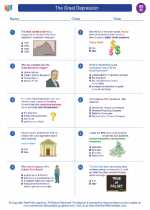Hoovervilles
Hoovervilles were makeshift communities of homeless people during the Great Depression. They were named after President Herbert Hoover, who was in office when the economic crisis hit. These communities were often located in shantytowns and consisted of tents, shacks, and other improvised housing. Hoovervilles emerged as a result of widespread unemployment, poverty, and the lack of affordable housing options.
Causes of Hoovervilles
Several factors contributed to the rise of Hoovervilles:
- Unemployment: The Great Depression led to massive job losses, leaving many people without a source of income to afford proper housing.
- Foreclosures: Many individuals and families lost their homes due to the inability to pay mortgages or rent.
- Financial Instability: Banks and financial institutions collapsed, leading to a financial crisis that further exacerbated homelessness.
- Decline in Agricultural Prices: Farmers suffered from falling crop prices, leading to rural poverty and displacement.
Living Conditions in Hoovervilles
The living conditions in Hoovervilles were extremely difficult:
- Basic Shelter: Residents lived in makeshift shelters constructed from salvaged materials such as wood, cardboard, and metal.
- Lack of Sanitation: There was often a lack of proper sanitation facilities, leading to health concerns and the spread of diseases.
- Food Scarcity: Many residents struggled to obtain an adequate supply of food, further exacerbating their hardships.
- Community Support: Despite the challenges, residents often formed strong community bonds and supported each other through mutual aid and resource sharing.
Government Response
The Hoover administration's response to the crisis was criticized for being inadequate. Hoovervilles became symbols of the government's failure to address the plight of the homeless and economically distressed.
Legacy
Hoovervilles serve as a reminder of the human impact of economic downturns and the importance of social safety nets to protect vulnerable populations during times of crisis.
Study Guide
To further understand the significance of Hoovervilles and their impact on society, consider the following questions:
- What were the main causes of Hoovervilles during the Great Depression?
- How did the living conditions in Hoovervilles reflect the hardships faced by their residents?
- What role did community support play in Hoovervilles, and how did residents cope with their circumstances?
- What criticisms were directed at the government's response to the Hooverville crisis, and what lessons can be drawn from this historical episode?
By exploring these questions, you can gain a deeper understanding of the social, economic, and political dimensions of the Great Depression and its impact on American society.
[Hoovervilles] Related Worksheets and Study Guides:
.◂Social Studies Worksheets and Study Guides Eighth Grade. The Great Depression

 Worksheet/Answer key
Worksheet/Answer key
 Worksheet/Answer key
Worksheet/Answer key
 Worksheet/Answer key
Worksheet/Answer key
 Worksheet/Answer key
Worksheet/Answer key
